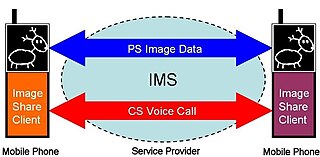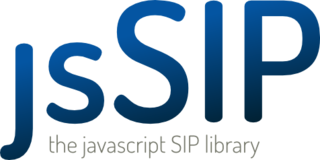The Session Initiation Protocol (SIP) is a signaling protocol used for initiating, maintaining, and terminating real-time sessions that include voice, video and messaging applications. SIP is used for signaling and controlling multimedia communication sessions in applications of Internet telephony for voice and video calls, in private IP telephone systems, in instant messaging over Internet Protocol (IP) networks as well as mobile phone calling over LTE (VoLTE).
Simple Network Management Protocol (SNMP) is an Internet Standard protocol for collecting and organizing information about managed devices on IP networks and for modifying that information to change device behaviour. Devices that typically support SNMP include cable modems, routers, switches, servers, workstations, printers, and more.
An application layer is an abstraction layer that specifies the shared communications protocols and interface methods used by hosts in a communications network. An application layer abstraction is specified in both the Internet Protocol Suite (TCP/IP) and the OSI model. Although both models use the same term for their respective highest-level layer, the detailed definitions and purposes are different.

Extensible Messaging and Presence Protocol is an open communication protocol designed for instant messaging (IM), presence information, and contact list maintenance. Based on XML, it enables the near-real-time exchange of structured data between two or more network entities. Designed to be extensible, the protocol offers a multitude of applications beyond traditional IM in the broader realm of message-oriented middleware, including signalling for VoIP, video, file transfer, gaming and other uses.
In computer and telecommunications networks, presence information is a status indicator that conveys ability and willingness of a potential communication partner—for example a user—to communicate. A user's client provides presence information via a network connection to a presence service, which is stored in what constitutes his personal availability record and can be made available for distribution to other users to convey their availability for communication. Presence information has wide application in many communication services and is one of the innovations driving the popularity of instant messaging or recent implementations of voice over IP clients.
STUN is a standardized set of methods, including a network protocol, for traversal of network address translator (NAT) gateways in applications of real-time voice, video, messaging, and other interactive communications.
OMA SpecWorks, previously the Open Mobile Alliance (OMA) is a standards organization which develops open, international technical standards for the mobile phone industry. It is a nonprofit Non-governmental organization (NGO), not a formal government-sponsored standards organization as is the International Telecommunication Union (ITU): a forum for industry stakeholders to agree on common specifications for products and services.

The Gateway Control Protocol is an implementation of the media gateway control protocol architecture for providing telecommunication services across a converged internetwork consisting of the traditional public switched telephone network (PSTN) and modern packet networks, such as the Internet. H.248 is the designation of the recommendations developed by the ITU Telecommunication Standardization Sector (ITU-T) and Megaco is a contraction of media gateway control protocol used by the earliest specifications by the Internet Engineering Task Force (IETF). The standard published in March 2013 by ITU-T is entitled H.248.1: Gateway control protocol: Version 3.
The SIP Forum is a nonprofit organization devoted to advancing the adoption of the Session Initiation Protocol (SIP), a signaling protocol for use in initiating, modifying, and terminating an interactive session among two or more users that involves multimedia elements such as voice, video, instant messaging, online games, and virtual reality.
Instant Messaging and Presence Protocol (IMPP) was an IETF working group created for the purpose of developing an architecture for simple instant messaging and presence awareness/notification. It was created on 1999-02-25 and concluded on 2004-09-08.

The Network Configuration Protocol (NETCONF) is a network management protocol developed and standardized by the IETF. It was developed in the NETCONF working group and published in December 2006 as RFC 4741 and later revised in June 2011 and published as RFC 6241. The NETCONF protocol specification is an Internet Standards Track document.
A back-to-back user agent (B2BUA) is a logical network element in Session Initiation Protocol (SIP) applications. SIP is a signaling protocol for managing multimedia Voice over Internet Protocol (VoIP) telephone calls. A back-to-back user agent operates between both end points of a communications session and divides the communication channel into two call legs, and mediates all SIP signaling between the endpoints of the session, from establishment to termination. As all control messages for each call flow through the B2BUA, a service provider may implement value-added features available during the call.
Peer-to-peer SIP (P2P-SIP) is an implementation of a distributed voice over Internet Protocol (VoIP) or instant messaging communications application using a peer-to-peer (P2P) architecture in which session control between communication end points is facilitated with the Session Initiation Protocol (SIP).

Image Share is a service for sharing images between users during a mobile phone call. It has been specified for use in a 3GPP-compliant cellular network by the GSM Association in the PRD IR.79 Image Share Interoperability Specification.
In computer networking, the Message Session Relay Protocol (MSRP) is a protocol for transmitting a series of related instant messages in the context of a communications session. An application instantiates the session with the Session Description Protocol (SDP) over Session Initiation Protocol (SIP) or other rendezvous methods.
The Media Gateway Control Protocol (MGCP) is a signaling and call control communications protocol used in voice over IP (VoIP) telecommunication systems. It implements the media gateway control protocol architecture for controlling media gateways connected to the public switched telephone network (PSTN). The media gateways provide conversion of traditional electronic media to the Internet Protocol (IP) network. The protocol is a successor to the Simple Gateway Control Protocol (SGCP), which was developed by Bellcore and Cisco, and the Internet Protocol Device Control (IPDC).

Blink is a Session Initiation Protocol (SIP) client distributed under the Blink license.
The Session Initiation Protocol (SIP) is the signaling protocol selected by the 3rd Generation Partnership Project (3GPP) to create and control multimedia sessions with two or more participants in the IP Multimedia Subsystem (IMS), and therefore is a key element in the IMS framework.

JsSIP is a library for the programming language JavaScript. It takes advantage of SIP and WebRTC to provide a fully featured SIP endpoint in any website. JsSIP allows any website to get real-time communication features using audio and video. It makes it possible to build SIP user agents that send and receive audio and video calls as well as and text messages.





